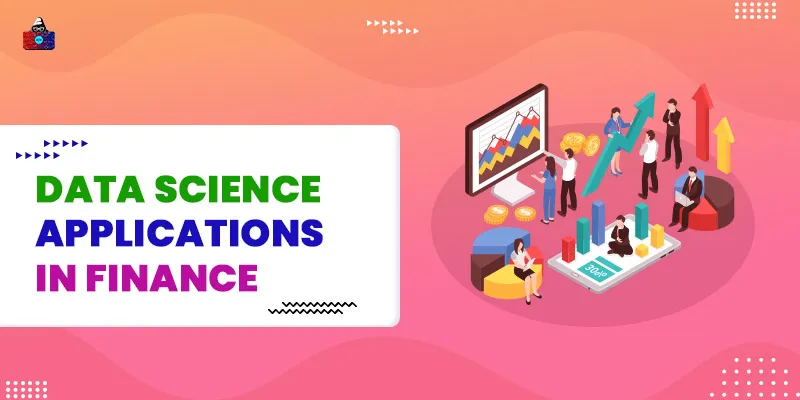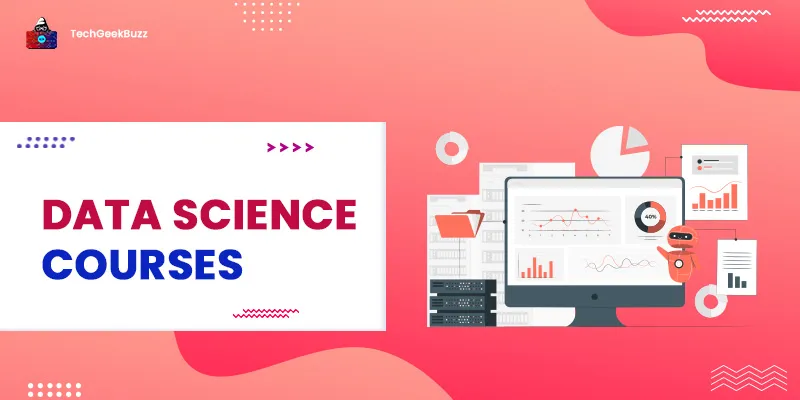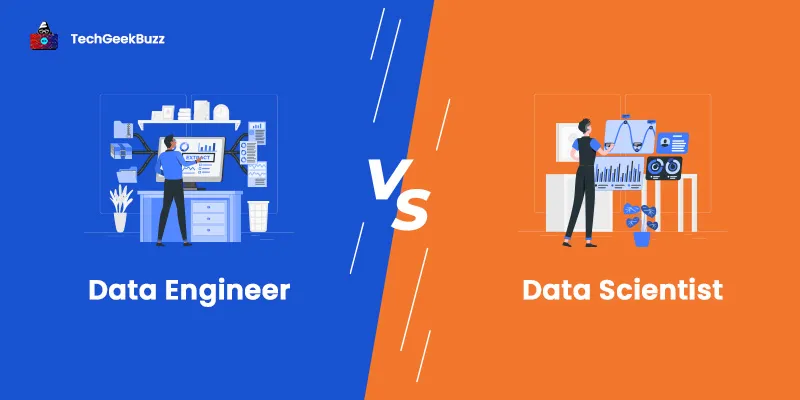Data science has changed the way businesses work today. Many domains today leverage it, including finance. As such, there are many data science applications in finance. Financial analysts nowadays rely heavily on data for many tasks, like fraud detection, managing risks, securing transactions, customer analytics, and predictive analytics. Data is given the utmost importance in the field of finance and helps businesses stand out and innovate unique solutions. Not just that, big data analytics and data modeling help in keeping confidential data secure and prevent unauthorized access to data. Same way, data visualizations help banking and other financial niches to present insights in an easy-to-understand manner, produce detailed reports, measure performance, and make better decisions. Some of the most popular tools for data analysis and visualization are PowerBI, Tableau, and Qlik. To perform data science for finance, you should know programming languages like R, Python, or Java and have strong domain knowledge. Also, you should be aware of time-series models and forecasting, such as statistical inference, clustering, trends, oscillations, moving averages, time-series data, formats, and autocorrelation. You also need to have basic SQL skills specific to data science. If you are new to the finance domain, you can take up the financial engineering course from Coursera .
How has Data Science Changed Finance?
Finance, as we know, by and large, relies on data. Financial analysis was pretty much popular before the term ‘data science’ officially came into the picture. Earlier, all the processes were performed separately but now they come under the same umbrella of data science. The presence of big data and advanced analytics have made data science extremely important for handling financial data. Due to powerful data science applications in finance, financial institutions are now able to capture data, clean and organize it, extract features, find trends and patterns, and do many complex tasks using the dataset. The presence of tools and techniques makes it further easier to analyze and get accurate insights from data. Machine learning and deep learning, which are the 2 important aspects of the data modeling phase of data science, are extensively used to derive algorithms that can improve on their own on the basis of more information and feedback.
Data Science Applications in Finance
There are many applications of data science in finance, and in this article, we will discuss the most prominent ones:
1. Algorithmic Trading
One of the most important ways data science has changed the entire finance and banking scenario is algorithmic trading. It involves high-speed computations and complex mathematical formulae that help financial companies come up with unique trading strategies, prevent human errors, and avoid repetition of previous mistakes. Through algorithmic trading, the machine can perform trade based on a particular algorithm multiple times in a second and with varying degrees of volume. The traders are in multiple markets and do not require any approval from the analyst. This avoids missing trading opportunities due to human error or hesitation. Algorithms are nothing but a set of rules that make decisions for trading. Algorithmic trading uses a reinforcement model, where any mistake is penalized heavily. Based on the model performance, we adjust the hyperparameters to make the model better for predictions. Models can find inconsistencies and only make trades that result in profits. Algorithmic trading has a high frequency, making it take up every feasible trade. A set of pre-defined conditions decides the feasibility of the trade. Sometimes the conditions result in a false signal, thus making incorrect trading decisions. Such cases require human intervention. For example, if there is an unforeseen incident like a fire, or an accident, the model may not work even if it is highly efficient. Finance companies are spending a fair share of their money on obtaining exclusive rights to data. With more data, we can reduce human intervention, and models can become better. Thus, it promotes better business growth.
2. Fraud Detection
With an increase in the number of digital transactions, protecting data from fraudulent transactions has become essential and more complex as well. However, through big data analytics, it is possible to track fraudulent transactions, mostly credit card frauds and identity thefts. To identify and prevent these frauds requires extensive data knowledge and special analysis techniques. Some of the techniques are:
- Pre-processing techniques, like data correction, validation, and finding missing values.
- Probability distributions and finding statistical parameters, such as mean, mode, and median.
- Time-series analysis.
- Clustering, classification, regression, and association to find relationships, patterns, and trends in the data (data mining).
- Anomaly detection to find suspicious behavior, estimate risks, remove false alarms, etc.
- Some AI techniques like expert systems, pattern recognition, neural networks, and expert systems.
3. Risk Analytics and Risk Modeling
Risk management is crucial for all types of financial operations, be it banking transactions, market price fluctuations, or consumer behavior. Using big data analytics can give real-time intelligence and help risk management systems detect risks and act upon them well ahead of time. Risk management highly depends on regression algorithms as it is quantitative. Regression techniques find use in forecasting realized variance, cross-sectional regression, and optimal portfolio allocation. Quantitative finance also uses feature selection for predictive modeling. This is most often done using Principle Component Analysis . Some of the common applications of data science for risk management are:
-
Financial market risk
Simulations like Monte Carlo help calculate Credit Value Adjustment (CVA) with good speed and quality. This way, banks can price their path-dependent derivatives in a better and advanced way than their competitors.
-
Credit risk
Analytics can create predictive models that are robust and accurate to assess the borrowers and customers on the basis of their behaviors and usage patterns. Not only the transaction data, history, demographics, etc. but also a user’s social posts like going for trips, having a new job, getting married can be important factors to create risk indicators.
-
Anti-money laundering
Traditional systems to prevent money laundering are tedious and time-consuming. They are somewhat prone to errors as well. You can improve these systems greatly by performing statistical analysis and data visualization to detect suspicious transactions, terrorist activities, etc. Advanced data science tools and techniques can prevent money laundering in the early stage by giving real-time actionable insights.
4. Customer Data Management
Customer data can be generated in various forms – through banking transactions, online shopping, or even through social media platforms. Multiple sources contribute to huge volumes and a variety of structured and unstructured data. Structured data can be easily managed using RDBMS, while unstructured data is stored and processed using big data frameworks , like Apache Hadoop and Apache Spark. Once the customer data is stored properly, we can use machine learning algorithms to analyze customer information through mining and text analytics.
5. Personalized Content
Based on user’s data, like credit history, income, browsing history, and many other features, personalized content in the form of offers and discounts can be shown to the customers. This helps in better conversions, improvement in the quality of sales calls (targeted), and builds a loyal customer base. Personalization can be done on the basis of the usage of services or the user’s interest(s). It creates customer segmentation, helps channelize marketing content to the right person(s), and creates more awareness among the target group.
6. Lifetime Value Prediction
This essentially means how valuable a customer is for your company in monetary terms. Based on this information, you can decide whether the customer is worth spending time on or not. The sales minus the returns over a year is the net spend on a customer. This value is useful to predict customer lifetime value (CLTV). Financial institutions use CLTV to calculate marginal profit per customer, cost of acquiring new customers, expected retention rate, and customer’s future cash flows.
7. Recommendation Engines
If you have been following data science for some time, you might have heard the word ‘recommendation engine’ in the context of movie recommendations by Netflix or product recommendations by Amazon. In finance, recommender systems offer insights into risks and favorable configurations to trade a product in the market. This and collaborative filtering together provide better suggestions to users.
8. Customer Support
Through data science, we can make customer support more accurate, personal, and automated. This enhances productivity and speed of resolving the issues. This is most helpful, particularly in the banking sector, where all the activities are service-based. One good example is a chatbot that can resolve the most common problems using a set of rules.
How Can you Become a Financial Data Scientist?
More than the skills, the value that you bring sells more! By value, we mean 3 main factors:
- Reducing cost,
- Increasing the revenue, and
- Maximizing profits!
Apart from the theoretical knowledge of statistics, decision science, predictive analysis, domain, and technical knowledge, you also need data munging capabilities and the ability to extract relevant and accurate information from datasets. Mind you, this is the most time-consuming phase of data science and also a differentiating factor between an average and an excellent data scientist. That said, skills do give you a kick-start. You need not acquire all the skills at once, but having a checklist never hurts. Check out our detailed article on how to become a data scientist to know more.
Conclusion
That sums up our discussion on data science applications in finance, many other applications are listed here . We have seen above how data science has become critical in using financial data for use-cases like customer data management, providing personalized services, risk analytics, algorithmic trading, and fraud detection. The financial industry was one of the first to apply data science tools and techniques to collect financial data and analyze it. As such, it is today enjoying the fruits of doing so. Most top financial institutions, like Citibank, JP Morgan, Goldman Sachs, and HSBC are hiring data scientists in large numbers every year for enhancing profits, understanding customers, forecasting, and business innovations in the field. Learn more about financial data analytics . People are also reading:
- Who is a Data Scientist & How to Become a Data Scientist?
- How Much Is a Data Scientist Salary?
- What is Data Science?
- Introduction to Classification Algorithms
- What are Statistics and Probability?
- Data Analysis Techniques
- Decision Tree in Machine Learning
- Best Data Analytics Tools
- Data Science vs Machine Learning
- Data Analyst Salary





Leave a Comment on this Post